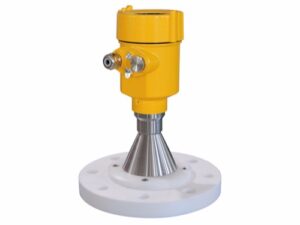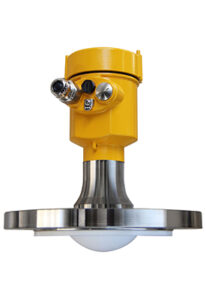The non-contact radar level meter is an advanced level-measuring instrument that can measure levels without contact with the measured medium. What are its features and selection principles?
A non-contact radar level meter is an instrument that measures the level of a medium without contact with the medium being measured, by sending and receiving electromagnetic signals via an antenna. Compared to contact radar level meters, it has more advantages, such as a large range of 0-70 meters, while the rod contact radar is only 0-6 meters and the cable contact radar is only 0-35 meters. There is also low maintenance, as there is no need for contact with the measured medium, making it easy to install and maintain.

There are several selection principles for non-contact radar level meters that we must go over.
1. Radar level meters are based on the emission-reflection-acceptance process to achieve level measurement, so the reflectivity of the measured medium to the radar wave must be considered, and the reflectivity of the medium to the radar wave is proportional to the dielectric constant of the medium.
At present, the minimum dielectric constant required by mainstream radar level meters is approximately 1.5. For some media that have just passed the critical point, such as liquefied petroleum gas, the dielectric constant is about 1.6.
In this critical situation, if a non-contact radar level meter is used, a wave-guide tube is generally added to enhance the radar wave return signal to meet the measurement requirements.
2. Reasonable choice of detection accuracy, different application sites on the radar level meter accuracy requirements are different, generally divided into measurement level and industrial control level.
Metering level radar level meter accuracy ± 1mm, FM radar level meter continuous emission of electromagnetic wave measurement, fast response, this form of radar level meter power consumption, circuit complex, high cost, using the four-wire system. Dosimeter radar is generally used in applications such as tank farms where metering is required.

3. The explosion-proof level should be selected reasonably, when the instrument is installed in an explosion-proof area, it should be selected according to the category of the explosion-proof area
When the instrument is installed in an explosion-proof area, it is necessary to select the appropriate explosion-proof type according to the category of the explosion-proof area and the group of combustible media.
The two types of explosion-proof instruments should not be mixed, the gas explosion hazard sites use intrinsically safe, explosion-proof instruments (not applicable in Zone 0) and other forms of instruments, while the dust and fiber explosion hazard sites must use dust explosion-proof instruments

4. Reasonable choice of range, according to the actual working conditions to determine the range, choose the corresponding range of radar level meter models. Different ranges of radar level meter transmitting power are different, the higher the range the greater the power. If you choose a high-power radar level meter for small range conditions, it will be a waste of energy, and conversely, if you choose a radar level meter with too little power for large range conditions, you will not be able to measure accurately.
5. Reasonable choice of antenna material and model, according to the working conditions of the reasonable choice of antenna material, high-temperature media, then choose a high-temperature antenna, media corrosive strong corrosion-resistant antenna. Part of the working conditions, in order to ensure that the radar level meter antenna can be inserted into the tank inside, you need to choose an extended antenna, special extension type, etc.
The above is the characteristics of a non-contact radar level meter and the selection of notes, I hope that can help you.
